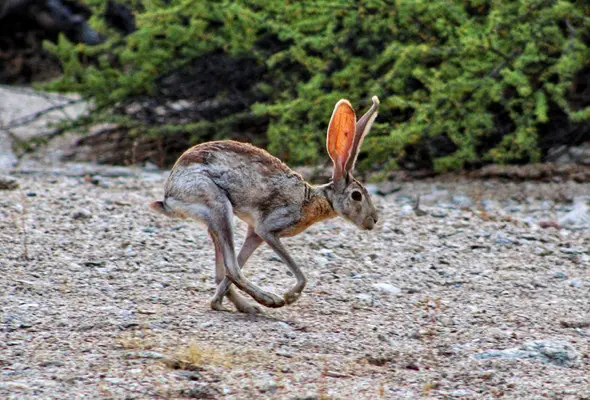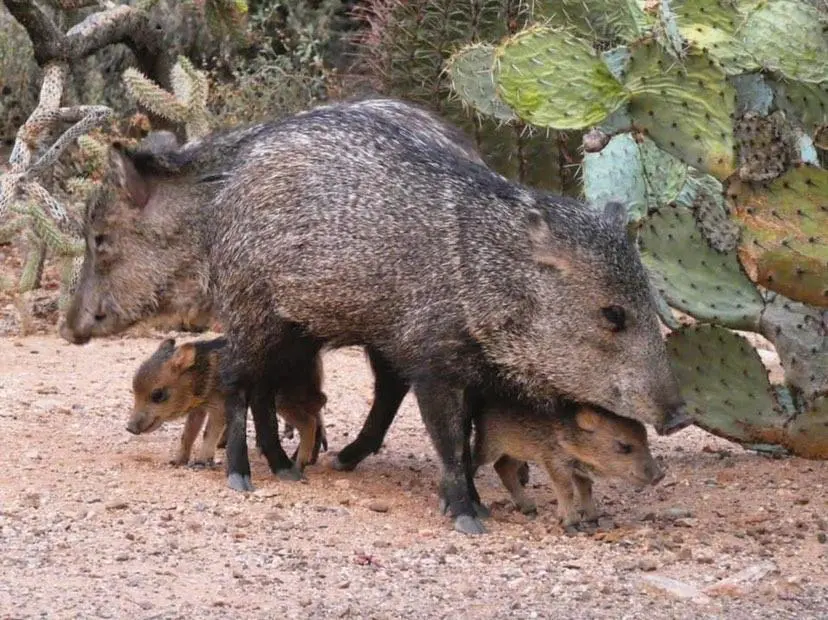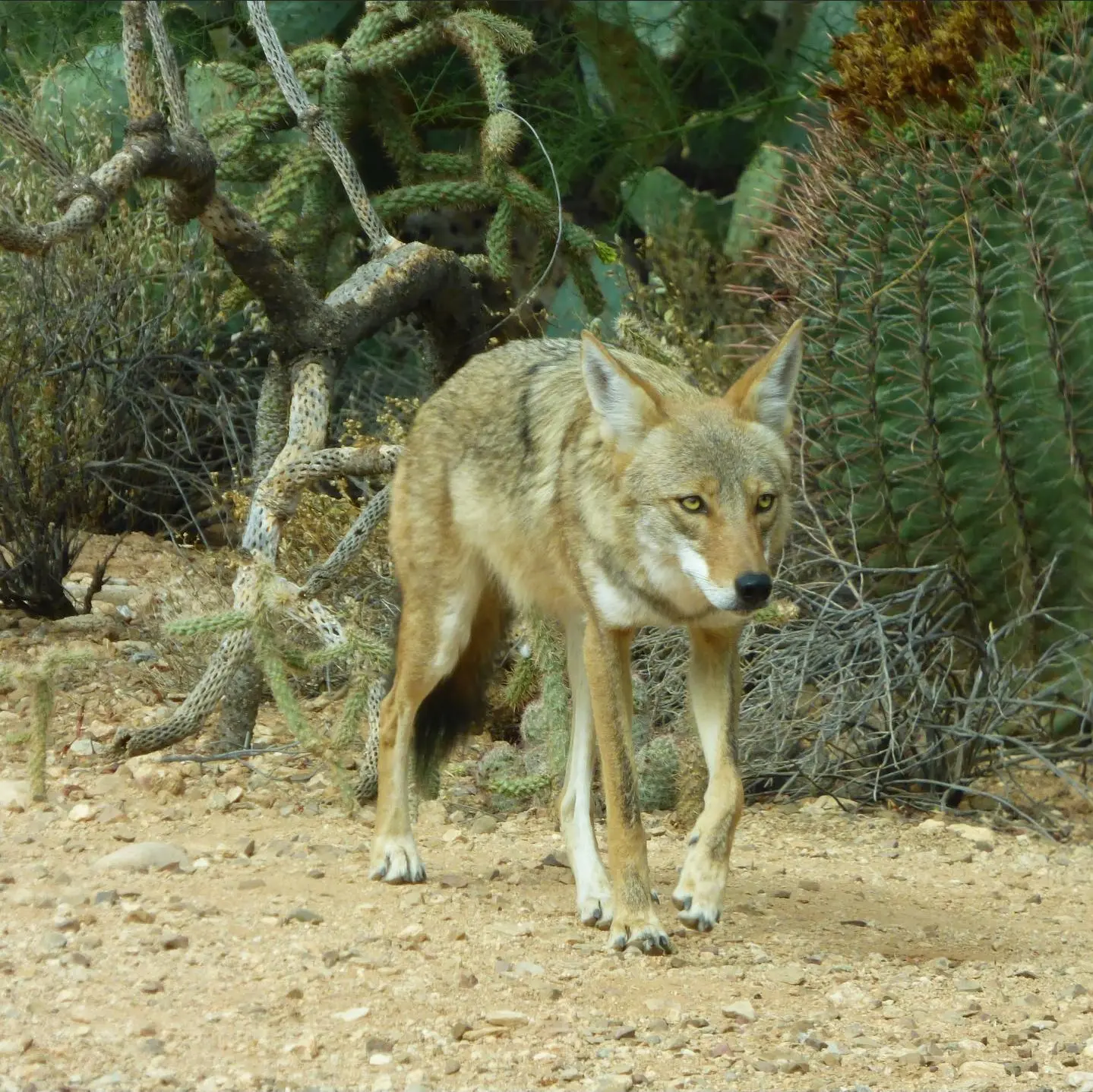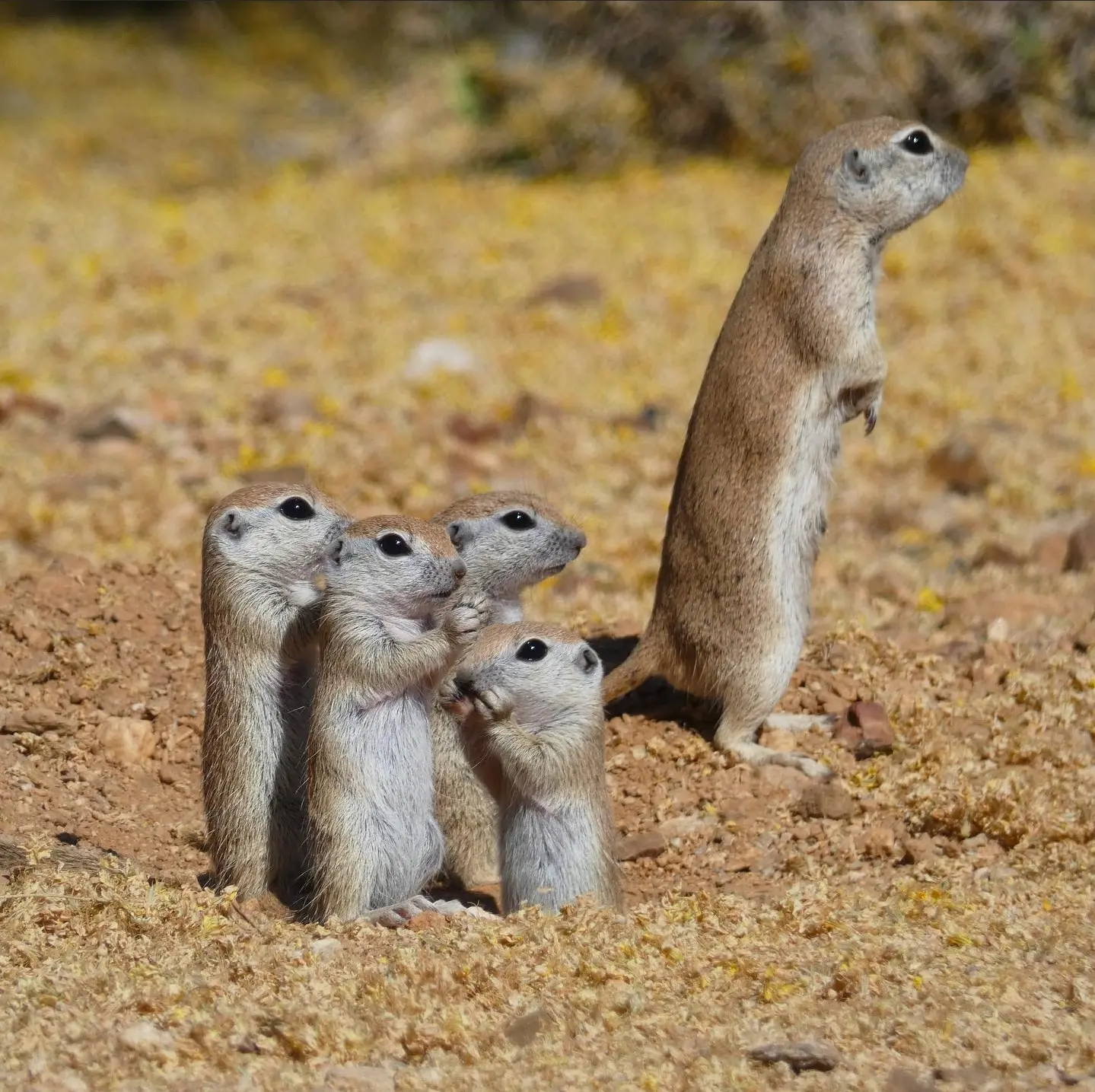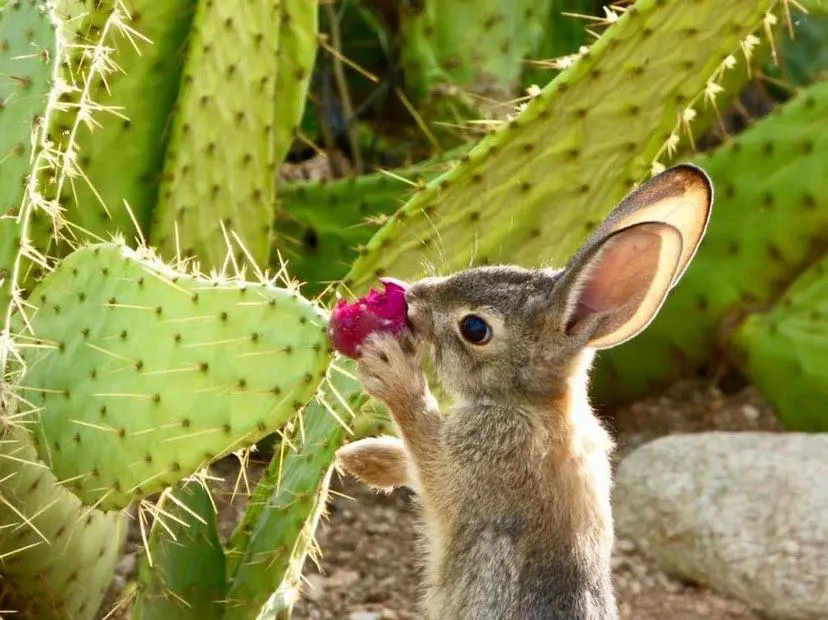Black-Tailed Jackrabbit
Lifespan • In the wild they live up to 13 years, with an average of less than 6 years.
Diet • Deer, javelina, bighorn sheep, elk, small mammals, and occasionally livestock and pets.
Habitat • Most commonly rocky or mountainous terrain.
Additional Info • 70 to 150 pounds, and 5 1/2 to 8 feet long. (males usually larger than females)
Can jump 20 feet vertically, and 40 feet horizontally in a single leap.
Territories range from 10 to 150 square miles.
Rarely do they vocalize, unless threatened or breeding.
Javelina
Lifespan • In the wild they live up to 10 years.
Diet • Herbivores. Agave, mesquite beans, prickly pear, and other green vegetation. And sometimes lizards, dead birds, and rodents.
Habitat • Desert washes, saguaro and palo verde forests, oak woodlands, and grasslands with mixed shrubs and cacti.
Additional Info • They have a scent gland on top of their rump that they rub on rocks and tree stumps to mark their territory. As well as rub on each other to help with identification.
They are categorized as peccary and not pigs.
The young are often called “reds” due to the red color of their hair.

Mountain Lion
Lifespan • In the wild they live up to 13 years, with an average of less than 6 years.
Diet • Deer, javelina, bighorn sheep, elk, small mammals, and occasionally livestock and pets.
Habitat • Most commonly rocky or mountainous terrain.
Additional Info • 70 to 150 punds, and 5 1/2 to 8 feet long. (males usually larger than females)
Can jump 20 feet vertically, and 40 feet horizontally in a single leap.
Territories range from 10 to 150 square miles.
Rarely do they vocalize, unless threatened or breeding.

Gray Fox
Lifespan • In the wild they live 7 to 10 years.
Diet • Omnivores. Eating small mammals, eggs, insects, birds, fruits, acorns and berries.
Habitat • Rocky canyons and ridges but can also be found in wooded areas, open desert and grasslands. They live in dens in a rocky cleft or underground burrow but have been known to use hollow trees
Additional Info • The only member of the dog family that climbs trees.
They can reach speeds up to 28 miles per hour for short amounts of time.
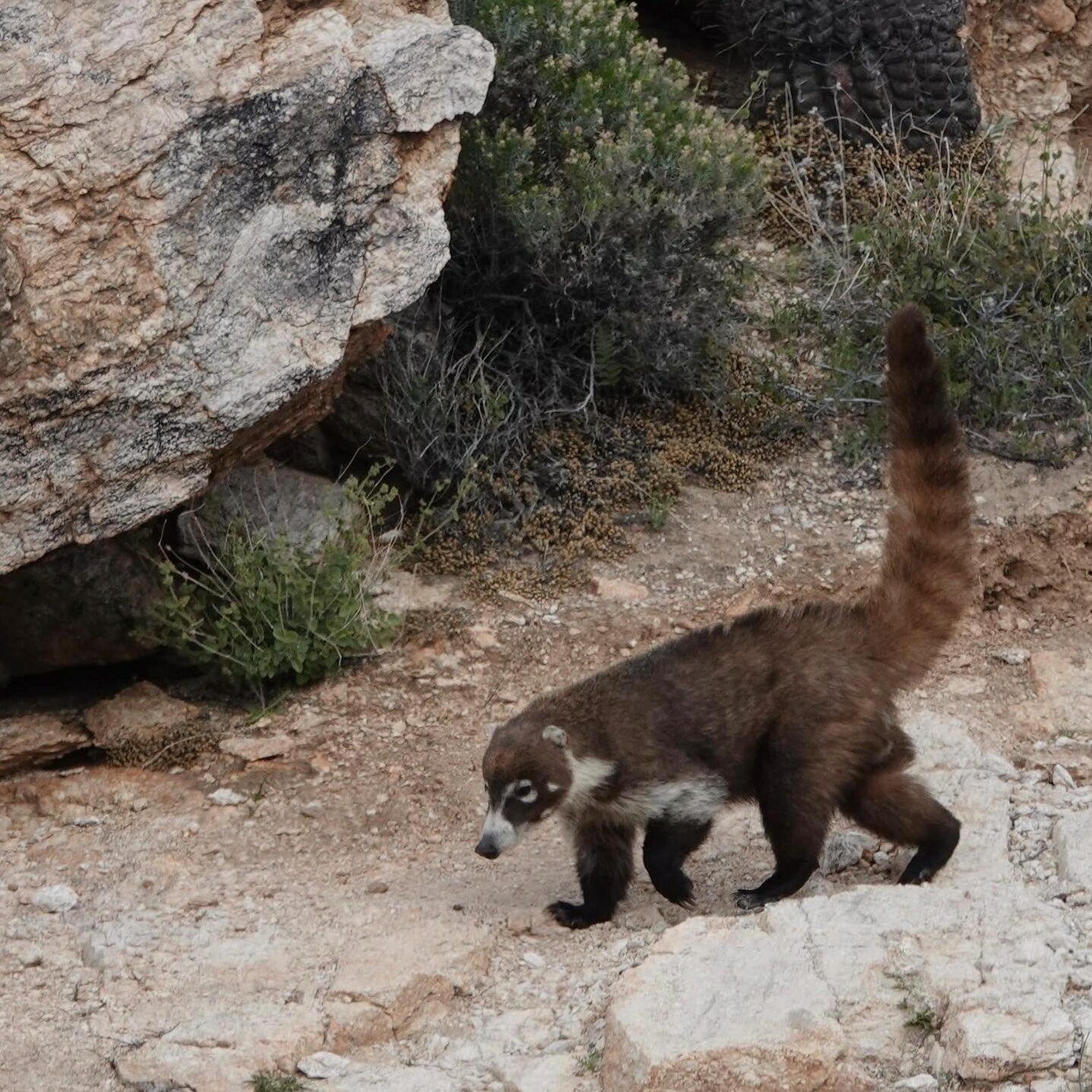
Coati
Lifespan • In the wild they live up to 7 years.
Diet • Fish, frogs, lizards, aquatic insects, invertebrates, birds, eggs, mice, fruit, nuts, and grains.
Habitat • Rocky canyons, den in caves, rocky crevices, and trees.
Additional Info • Most active in the morning and late afternoon.
Member of the racoon family.

White-Tailed Deer
Lifespan • Average lifespan is 4.5 years.
Diet • Herbivores. Mesquite leaves and beans, catclaw, jojoba, cactus fruit, buckbrush, fairy duster, and graze on a variety of formes and grasses.
Habitat • Along streams and rivers. Open areas are used only when thrick shrubs or foresst are nearby.
Additional Info • Generally found at higher elevations than Mule Deer.
A natural gait as they run. As opposed to the Mule Deer which runs with a stiff-legged bounding gate.

Bobcat
Lifespan • In the wild they live 10-15 years.
Diet • Carnivorous. Generally feeding on small mammals and birds. But will also eat lizards, snakes, and small pets.
Habitat • Typically found in rimrock and chaparral (broad-leaved evergreen shrubs, bushes, and small trees usually less than 2.5 m (about 8 feet) tall; together they often form dense thickets) areas.
Additional Info • Most active in the sunrise and sunset.
Territory is usually one to 12 miles.
Average litter is two to three kittens. And they stay with their mother for seven to twelve months.
Able to jump as high as 12 feet.

Mule Deer
Lifespan • Average lifespan is 9 to 11 years.
Diet • Herbivores. Mesquite leaves and beans, catclaw, jojoba, cactus fruit, buckbrush, fairy duster, and graze on a variety of formes and grasses.
Habitat • Along streams and rivers. Open areas are used only when thrick shrubs or forest are nearby.
Additional Info • Mule Deer have no upper teeth, only a hard palate.
Females usually give birth to two fawns. But if it’s their first birth, they often only have one.

Skunk
Sabino Canyon Species • Striped, Hooded, Western Spotted, and Hog-Nosed Skunk
Lifespan • In the wild they live 7-8 years.
Diet • Omnivores. Plants, insects, larvae, worms, fruit, eggs, reptiles, small mammals, and fish.
Habitat • Typically living in abandoned burrows. Under large rocks and in hollow logs.
Additional Info • Before spraying, a skunk will often charge at an attacker, stomp it’s front legs or hiss.
None of the species of Skunk that reside in Sabino Canyon can climb trees. There is only one skunk (Eastern Spotted Skunk) that can climb trees.
Skunks give birth to two to ten offspring at a time.
Skunks are nocturnal, and forage for food while most humans and animals sleep.
Coyote
Lifespan • Average lifespan is 10-14 years.
Diet • Omnivores. They will eat, or try to eat just about anything in the Sonoran Desert. Cactus fruit, mesquite beans, flowers, insects, rodents, lizards, rabbits, birds, and snakes.
Habitat • Desert scrub, grasslands, and the foothills.
Additional Info • Coyotes sing as a way to communicate with other coyote families. And to keep track of their own family.
Round-Tailed Ground Squirrel
Lifespan • In the wild they live eight to nine years.
Diet • Omnivores. Green vegetation, seeds, and some insects.
Habitat • They favor flat, sandy areas like creosote scrub vegetation. Living in burrows.
Additional Info • The Round-Tailed ground squirrel either digs its own burrow or uses an old burrow of another species. The entrance is at the foot of a bush and ther is no mound to indicate this since the soil is scattered.
The average litter size is six, with the largest recorded being twelve.

Rock Squirrel
Lifespan • Average lifespan is one to two years.
Diet • Omnivores. Seeds, insects, esquite beans, fruits, carrion, small birds, and eggs.
Habitat • Rocky cliff areas and boulder piles.
Additional Info • Litters range from three to nine.
They live in colonies with several females and one dominant male that will fight other mature males to protect the group. There may be subordinate males at the outer boundaries of the group.

Antelope Ground Squirrel
Lifespan • In the wild they live two to four years.
Diet • Omnivores. They feed on a variety of desert plants that range from the fruit and seeds of cactus like barrel cactus, cholla cactus and prickly pear cactus. They will also eat mesquite beans, insects, and an occasional mouse.
Habitat • Rocky cliff areas and boulder piles.
Additional Info • It is not unusual to see these squirrels in a plant such as a barrel cactus eating the fruit. It is not known how they avoid the sharp spines of the cactus.
These squirrels practice what is known as “heat dumping”. When their body temperature reaches its upper limits they will get into a cool shady spot and lay down spread-eagel with their belly pressed against the cool ground. This releases the heat from their body.

Bighorn Sheep
Lifespan • Average lifespan is ten to twelve years. But can reach 17 years or older.
Diet • Fluff grass, catsclaw, ocotillo, spurges, buckwheat, mescal, janusia, slim triodia, indian wheat, filaree, and weeds in season.
Habitat • Desert mountain ledges and grassy basins.
Additional Info • At their peak, it’s estimated that there were 2 million. Desert populations are now around 20,000. Mountain populations are at about 45,000. Arizona has a population of about 6,000.
Desert Bighorn Adult males weigh in between 160 and 200 pounds. With a max of 225 pounds. Females between 75-130 pounds. Considerably lighter than the Rocky Mountain Bighorns which can weigh up to 340 pounds

Pocket Gopher
Lifespan • 3 years.
Diet • Vegetarians. Roots, tubers, grasses, green plants, and prickly pears.
Habitat • Found throughout the Sonoran Desert region where there are easily dug soils, such as those in riparian areas, washes, and mesquite bosques.
Additional Info • They perform a valuable service in turning and and aerating the soil. Many other creatures benefit from these holes and tunnels including rabbits, ground squirrels, mice, skunks, snakes, lizards, and toads.

White Throated Wood Rat
Lifespan • Only a few years..
Diet • Prickly pear cactus, seeds, leaves, and fruit from other plants.
Habitat • Low desert to pine forests. Burrows, caves, and caliche pockets, Or in houses made of sticks, cactus joints. and other debris.
Additional Info • Their nests can get as large as 4 feet and 8 feet wide. As they continually add more nesting materials. They especially love shiny objects for building their nest.
Generally the nest is only occupied by one, unless it is a mother with it’s young.

Lesser Long-Nosed Bat
Lifespan • About 20 years.
Diet • Exclusively feeding on the fruit and nectar of night blooming cacti including saguaro and organ pipe, as well as many species of agave.
Habitat • Found in desert scrub, caves, and mines.
Additional Info • Bats are the only mammals that can fly.
They can reach speeds up to 14 miles per hour in flight.
Desert Cottontail Rabbit
Lifespan • 2 years.
Diet • Herbivores. Including grasses, forbs, shrubs, and even cacti. Ninety percent of their diet is grass. They get most of their water from the plants they eat or dew on plants.
They are coprophagic, meaning they eat their own feces.Since grass is difficult to digest, the rabbits eat the first-formed set of pellets after a meal. Additional nutrition is extracted durin the second digestive process.
Habitat • Dry desertlike grasslands and shrublands, riparian areas, and pinyon-juniper forests.
Additional Info • To avoid overheating, desert cottontails have higher activity periods at night, light colored fur to minimize absorption of solar hear, and large ears with blood vessels just below the skin level that can radiate body heat to the air.
Cottontails can breed at 80 days old, then mate again soon after giving birth.
A males home range may be up to 15 acres in size, while a females home range can be less than one acre
Cottontails have been known to swim or climb trees when pursued by prey.
The cottontail’s tail functions as an alarm signal. When a rabbit raises its tail, the large white patch of fur on the bottom is exposed, serving as a warning signal to other cottontails.
